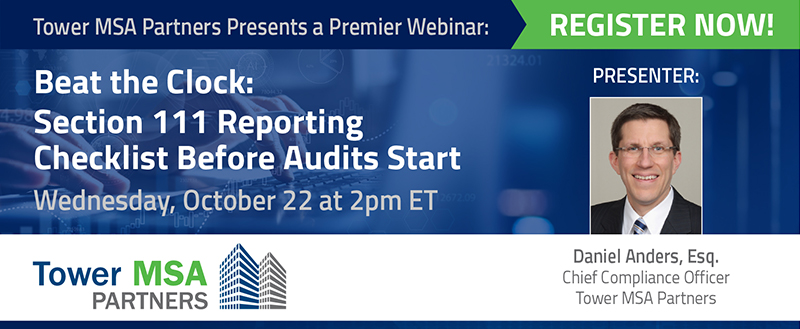Highlights from WCI TV at WCI 2025
Once again, Tower MSA Partners proudly sponsored WCI TV at the Workers’ Compensation Institute’s Annual Conference in Orlando, held August 17–20, 2025. Each year, WCI TV shines a spotlight on the people and ideas shaping the workers’ compensation community. This year’s theme, “Rockstar Careers: Finding Your Rhythm in Workers’ Comp,” invited industry leaders to share the unexpected ways they found their way into the field and the lessons they’ve learned along the way.
The conversations revealed humor, heart, and the shared passion that keeps this community strong. Below are highlights from the inspiring interviews.
Dan Anders – Tower MSA Partners
As Tower MSA Partners’ Chief Compliance Officer, Dan Anders is no stranger to the spotlight at WCI. He kicked off this year’s series by reflecting on how is own career path began outside the industry, in politics and law, before a colleague introduced him to workers’ compensation. What began as an unexpected opportunity turned into a 23-year journey.
“I didn’t know anything about it, but I needed a job. That began my 23-year journey in workers’ compensation.”
When asked what advice he’d give to those considering the field, Dan emphasized both sides of the practice—helping injured workers as a plaintiff’s attorney or solving problems as defense counsel. Either way, he said, it’s a career that offers variety and purpose.
Dan also credited mentors for shaping his path, from his first law firm partner who handed him his first Medicare Set-Aside file, to Tower’s retired CEO Rita Wilson:
“She exemplified how a Medicare compliance company can provide an exceptional level of customer service… and really make the lives of our client partners easier.”
Watch Dan’s full interview
Patti Colwell – Southwest Airlines
With 30 years at Southwest Airlines, Patti Colwell knows what it takes to build a career that lasts. Now the Manager of Workers’ Compensation Programs nationwide, Patti confessed she never sought out this career—it found her.
“I didn’t pick workers’ comp, it picked me. My boss said, ‘Boy, have I got a deal for you.’”
Over the last 25 years, she’s developed an approach centered on problem-solving and empathy. Patti stressed the importance of being flexible:
“You have to be able to live in the gray area. Even though it’s regulated… you may have to think outside those regulations to find the right solution and do the right thing.”
Keys to success, she added, include lifelong learning, compassion, and the ability to have tough conversations while still offering solutions. Patti credited her VP in Southwest’s People Department for giving her the confidence to take on workers’ comp in the first place:
“Because of her support, that really gave me the confidence boost I needed to say, ‘Yeah, I can do this.’”
Watch Patti’s full interview
Greg Hamlin – Berkley Industrial Comp
Greg Hamlin, Chief Claims Officer at Berkley Industrial Comp, oversees claims in some of the nation’s riskiest industries—construction, mining, and other high-hazard environments. But his career started far from insurance.
“As a kid, I wanted to do theater. Then I spent a couple years on the Navajo reservation and realized I loved giving back. Eventually, Liberty Mutual recruited me out of college.”
For Greg, workers’ comp is about stability, service, and impact:
“We’re meeting people on their worst days, and we’re helping them get back to work and recover.”
His advice to newcomers is practical and encouraging:
“It’s a very stable industry with lots of opportunity. You get to play in a lot of different sandboxes—law, finance, medicine—and really help people.”
Greg also shared wisdom passed down from a mentor who left a lasting impression:
“He always said, ‘Always think in a positive manner.’ In this industry, where we meet people in their darkest moments, that mindset really matters.”
Watch Greg’s full interview
Brenda Chitty – NARISK
For Brenda Chitty, Assistant Director of Workforce Development at NARISK, workers’ comp is about service at every level—injured workers, clients, and partners. Like many, she didn’t plan on the field; it found her.
“Workers’ compensation found me. I started in disability case management and then moved into a trucking company’s comp department—and I never left.”
Her advice for newcomers is rooted in humility and purpose:
“Make sure you want to be a servant. Workers’ compensation is about taking care of people. When you do, you’ll find it very rewarding.”
For those already a few years into the field, Brenda’s encouragement was simple but powerful:
“Stick it out. Stay true to who you are and what you know. Someone is counting on you.”
Brenda also credited her parents, who ran a furniture store, for teaching her customer service from an early age:
“I learned how to treat people from the age of four to 21. My parents were my biggest heroes.”
Watch Brenda’s full interview
Bryan Conner & Drew Cashatt – American Airlines
Perhaps the most dynamic interview came from Bryan Conner and Drew Cashatt of American Airlines, whose friendship and shared leadership embody the theme of servant leadership.
Bryan, once a flight attendant, pivoted into workers’ comp after realizing injured colleagues needed stronger advocacy:
“A flight attendant came into my office and said, ‘I’ve been injured and I needed more help.’ I took that as my life’s mission—to create an advocacy-based workers’ comp program.”
Drew’s path began loading luggage for TWA while in law school before he found his way into accommodations and workers’ comp. Both now lead programs designed to holistically support injured team members.
Their advice? Servant leadership.
“Be a servant to those injured workers. They’re at the lowest point in their lives. Advocate for them and help them recover successfully.” —Drew
Perhaps the most touching moment came when Bryan named Drew as the person who most impacted his career:
“You’re sitting right beside me. He is a servant leader, and together we know we can make a difference.”
Drew echoed the sentiment, underscoring the bond the two share as colleagues, accountability partners, and friends.
Watch Bryan & Drew’s full interview
Key Themes Across the Interviews
Across each conversation, a few themes rang loud and clear:
- Workers’ comp chooses you: Almost everyone admitted they didn’t plan for this career—it found them.
- Service is the core: Whether in airlines, TPAs, or insurers, the heartbeat of workers’ comp is caring for people during difficult times.
- Mentors matter: Each speaker credited mentors, colleagues, or family for shaping their journey.
- Adaptability and empathy: From “living in the gray area” to “always thinking positive,” success in this field requires both skill and heart.
Conclusion
The 2025 WCI TV “Rockstar Careers” series reminded us that workers’ comp is more than rules and claims—it’s a people business, built on service, resilience, and leadership. Each story revealed not just a career path, but a calling. Together, they form a chorus that makes this industry stronger, more compassionate, and, yes, a little more rock-and-roll.











